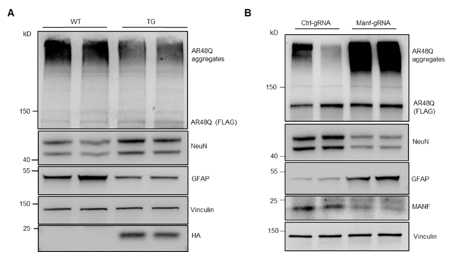NRR:暨南大学杨甦、李晓江团队揭示中脑星形胶质源性神经营养因子抑制在脊髓延髓肌萎缩中的潜在作用
撰文:朱文振,杨甦
多聚谷氨酰胺(polyglutamine,polyQ)疾病是一类以迟发性神经退变为特征的单基因遗传病 [1]。脊髓延髓肌萎缩,又称肯尼迪病,是首个被发现的多聚谷氨酰胺疾病,其致病基因是位于X染色体上的雄激素受体,编码响应雄激素的转录因子[2]。正常雄激素受体基因1号外显子存在9-34个CAG重复,而脊髓延髓肌萎缩患者中的重复次数则超过38个 [3]。突变的雄激素受体基因翻译产生多聚谷氨酰胺区域异常扩增的雄激素受体蛋白,该蛋白易发生错误折叠并聚集在细胞核中,改变蛋白质的相互作用并扰乱雄激素受体蛋白介导的转录调控 [4]。中脑星形胶质细胞源性神经营养因子(mesencephalic astrocyte-derived
neurotrophic factor,MANF)是一种新型神经营养因子,因其在帕金森病、脑卒中等多种脑疾病模型中发挥保护作用而受到关注 [5]。最近有研究提示雄激素受体可参与调控MANF的转录活性 [6],但带有多聚谷氨酰胺扩增的突变雄激素受体如何影响MANF的表达,以及MANF是否参与脊髓延髓肌萎缩的发病机制尚不明确。
中国暨南大学粤港澳中枢神经再生研究院杨甦、李晓江团队在《中国神经再生研究(英文)》(Neural Regeneration Research)上发表了题为“Reduced mesencephalic astrocyte–derived neurotrophic factor
expression by mutant androgen receptor contributes to neurodegeneration in a
model of spinal and bulbar muscular atrophy pathology”的研究。实验发现,多聚谷氨酰胺异常扩增的突变雄激素受体会导致MANF的表达降低。在小鼠脑内过表达MANF可抑制突变雄激素受体的蛋白聚集并降低其神经毒性;反之,敲低内源性MANF则可加剧突变雄激素受体的蛋白聚集及其造成的神经元损伤。由此揭示了中脑星形胶质源性神经营养因子是脊髓延髓肌萎缩的新致病机制和潜在治疗靶点。
雄激素受体是依赖雄激素配体的转录因子,其转录失调被确认是脊髓延髓肌萎缩的一项主要致病机制。因此,阐明突变雄激素受体引起的转录调控紊乱有着重要的科研和临床转化价值。最近的一项研究报道,在诱导多能干细胞分化的心肌细胞中,正常雄激素受体的功能会抑制MANF的转录 [6]。然而此调控功能是否存在于小鼠脑内尚不清楚。因此杨甦、李晓江等利用Western blot和PCR比较了2月龄雄性和雌性小鼠的大脑皮质、纹状体、小脑以及心脏中MANF蛋白和mRNA的表达,明确了MANF的表达具有性别和器官特异性:在心脏中,雄性小鼠MANF蛋白水平低于雌性小鼠,提示雄激素受体抑制MANF表达;在脑内,雄性小鼠MANF蛋白水平高于雌性小鼠,提示雄激素受体促进MANF表达(图1)。

图1 MANF的表达具有性别和器官差异性(图源:Qin et
al., Neural Regen Res, 2025)
随后,杨甦、李晓江等利用构建好的表达载体和腺相关病毒在小鼠脑神经瘤细胞系(Neuro-2a; N2a)和野生型小鼠的大脑皮质内分别表达正常(AR0Q)和突变(AR48Q)的雄激素受体。在N2a细胞系中,AR0Q可促进MANF的表达,而AR48Q丧失了该功能(图2A)。在雄性野生型小鼠的大脑皮质内,AR48Q在神经元的细胞核内异常聚集并造成MANF的表达水平降低(图2B和C)。通过检验NeuN、MAP2、PSD95等多个神经元标志蛋白,发现AR48Q导致神经元损伤(图2D)。考虑到MANF在多种脑疾病模型中具有神经保护作用 [7-9],这些结果提示突变雄激素受体降低MANF表达可能是脊髓延髓肌萎缩的一个潜在致病机制。

图2 突变雄激素受体使MANF表达降低并产生神经毒性(图源:Qin et
al., Neural Regen Res, 2025)
为验证上述假说,杨甦、李晓江等利用脑内过表达MANF转基因(MANF TG)小鼠。在MANF TG小鼠的大脑皮质表达AR48Q并重复上述神经病理检测。发现过表达MANF可以显著缓解突变雄激素受体对神经元的损伤(图3A)。并且该保护效果可能来源于MANF抑制AR48Q聚集体的形成(图3A)。研究还采用了相反的策略,通过CRISPR/Cas9基因编辑工具在野生型小鼠的大脑皮质内敲低内源性MANF同时表达AR48Q,发现MANF的减少加剧了神经元损伤,并且显著性增加了AR48Q聚集体的形成(图3B)。

图3 过表达和敲低MANF分别改善和加重突变雄激素受体的神经毒性(图源:Qin et
al., Neural Regen Res, 2025)
综上所述,此次研究表明,突变雄激素受体会降低MANF在脑内的表达,而MANF作为一种神经保护蛋白可以抑制突变雄激素受体的神经毒性。由此揭示了MANF的表达降低是脊髓延髓肌萎缩中神经元退变的一种分子机制,人为增加MANF的表达是治疗脊髓延髓肌萎缩的一种潜在方法。研究的局限性是未使用脊髓延髓肌萎缩的转基因小鼠模型,而是利用脑立体定位注射在小鼠的大脑皮质局部表达突变雄激素受体。因此该小鼠模型没有表现出明显的运动功能障碍。因此无法研究MANF表达变化对小鼠行为的影响。未来的研究需要使用脊髓延髓肌萎缩的转基因模型来深入探究MANF的表达变化对小鼠的运动功能以及寿命的影响。尽管如此,此项研究扩展了对于MANF的神经保护功能的认知。后续研究可以进一步探究MANF的神经保护分子机制,以及探索以MANF为靶点的神经修复策略。
原文链接:https://doi.org/10.4103/NRR.NRR-D-23-01666
参考文献
[1] Orr HT, Zoghbi HY. Trinucleotide
repeat disorders. Annu Rev Neurosci. 2007;30:575-621.
[2] Davey RA, Grossmann M. Androgen
receptor structure, function and biology: from bench to bedside. Clin Biochem
Rev. 2016;37(1):3-15.
[3] La Spada AR, Wilson EM, Lubahn DB, et
al. Androgen receptor gene mutations in X-linked spinal and bulbar muscular
atrophy. Nature. 1991;352(6330):77-79.
[4] Arnold FJ, Merry DE. Molecular
mechanisms and therapeutics for SBMA/Kennedy's disease. Neurotherapeutics.
2019;16(4):928-947.
[5] Yang S, Li S, Li XJ. MANF: A New
Player in the Control of Energy Homeostasis, and Beyond. Front Physiol.
2018;9:1725.
[6] Zhang Y, Sun C, Li Y, et al. Hormonal
therapies up-regulate MANF and overcome female susceptibility to immune
checkpoint inhibitor myocarditis. Sci Transl Med. 2022;14(669):eabo1981.
[7] Yang S, Huang S, Gaertig MA, et al.
Age-dependent decrease in chaperone activity impairs MANF expression, leading
to Purkinje cell degeneration in inducible SCA17 mice. Neuron.
2014;81(2):349-365.
[8] Airavaara M, Shen H, Kuo CC, et al.
Mesencephalic astrocyte-derived neurotrophic factor reduces ischemic brain
injury and promotes behavioral recovery in rats. J Comp Neurol.
2009;515(1):116-124.
[9] Voutilainen MH, Bäck S, Pörsti E, et
al. Mesencephalic astrocyte-derived neurotrophic factor is neurorestorative in
rat model of Parkinson's disease. J Neurosci. 2009;29(30):9651-9659.


